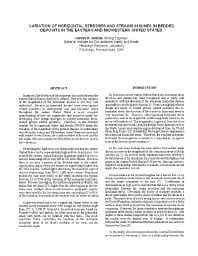Mining Publication: Variation of Horizontal Stresses and Strains in Mines in Bedded Deposits in the Eastern and Midwestern United States
Original creation date: August 2003
Authors: DR Dolinar
NIOSHTIC2 Number: 20023430
Proceedings of the 22nd International Conference on Ground Control in Mining, Peng SS, Mark C, Khair AW, Heasley KA, eds. Morgantown, WV: West Virginia University, 2003 Aug; :178-185
In general, the direction of the maximum horizontal stress in the Eastern United States is fairly well defined. However, the variation of the magnitudes of the horizontal stresses is not very well understood. Because the horizontal stresses cause severe ground control problems in underground coal and limestone mines throughout the Eastern United States, a more complete understanding of how the magnitudes vary would be useful for developing mine design strategies to combat horizontal stress-related ground control problems. Therefore, in this National Institute for Occupational Safety and Health (NIOSH) study, the variation of the magnitude of the horizon stresses in sedimentary deposits in the Eastern and Midwestern United States are examined with respect to two factors: the elastic modulus of the rock and the site depth. Stress measurements from 37 sites are used in the evaluation. Examining the applied excess strains indicates that the Eastern United States can be separated into high- and low-strain zones. For most of the Eastern United States, the maximum applied excess or tectonic strain ranges from only 300 to 550 micro strains. However, there is one area, a portion of the Beckley Seam in the central Appalachian region, where the strains are significantly higher than the other regions. In this higher strain zone, the maximum applied tectonic strains range from 700 to 1,000 micro strains. Regression models for each zone based on the elastic modulus can explain between 83% to 85% of the variation of the maximum horizontal stress. Because one region, the northern Appalachian district, has strains that are about 20% higher than the other regions in the low-strain zone, multiple strain models based on geographic regions were developed for the low-strain zone that can explain 87% to 91% of the maximum horizontal stress variation with the elastic modulus. Depth was found not to be a significant causal factor in any increase in the horizontal stress, even though the site depths ranged from 275 to 2,500 ft. Beyond a theoretical increase, based on Poisson's effect and gravity, no other increase in the horizontal stress with depth can be justified with these data. The most significant factor controlling the variation of the maximum horizontal stress is the elastic modulus of the rock, not the overburden depth.

NIOSHTIC2 Number: 20023430
Proceedings of the 22nd International Conference on Ground Control in Mining, Peng SS, Mark C, Khair AW, Heasley KA, eds. Morgantown, WV: West Virginia University, 2003 Aug; :178-185
- CFD Modeling of Fire Spread Along Combustibles in a Mine Entry
- Development of a Wireless Test and Measurement Tool for Use in Mines
- Horizontal Stress
- Overview of Ground Control Research for Underground Coal Mines in the United States
- Refuge Alternatives in Underground Coal Mines
- Roof Screening for Underground Coal Mines: Recent Developments
- Safe and Economical Inerting of Sealed Mine Areas
- SPONCOM - A Computer Program for the Prediction of the Spontaneous Combustion Potential of an Underground Coal Mine
- Technology News 526 - Proceedings of the International Workshop on Rock Mass Classification in Underground Mining
- Ultra-Low Frequency Through-the-Earth Communication Technology
- Wireless Mesh Mine Communication System